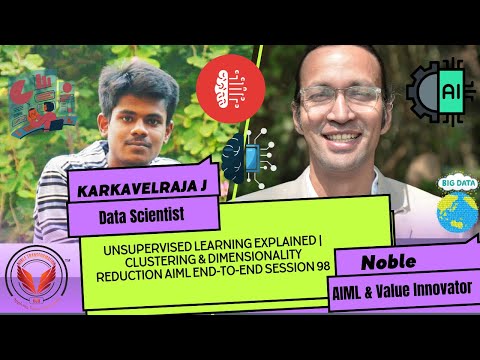filmov
tv
Hands-on Unsupervised Learning using Dimensionality Reduction via Matrix Decomposition (2nd)

Показать описание
2020.04.20 By Michael Sakano, Purdue University
This video is a part of a hands-on machine learning and data science training workshop conducted by nanoHUB in April 2020.
Matrix decomposition/factorization of multivariate data is a useful procedure to reduce the dimensionality of the information by representing the data as a product of two matrices. The most common method is Principle component analysis (PCA) which employs singular value decomposition on the data matrix to extract possible correlated features. While useful, the outputs are rarely interpretable. Therefore, a similar decomposition method called Non-negative matrix factorization (NMF or NNMF) forces an additional constraint that the values of the sub-matrices must be non-negative. The initial notebook will go into the algorithm regarding PCA in the context of learning linear relationship between two inputs. In the latter half, these two techniques are applied to a simulation of thermal decomposition of an energetic material RDX. As the chemical pathways become increasingly intricate throughout the decomposition evolution, we aim to group the entire process into three features. As will be seen, NMF does a better job of interpreting what might be contained in the features in the context of chemical bonds.
This video is a part of a hands-on machine learning and data science training workshop conducted by nanoHUB in April 2020.
Matrix decomposition/factorization of multivariate data is a useful procedure to reduce the dimensionality of the information by representing the data as a product of two matrices. The most common method is Principle component analysis (PCA) which employs singular value decomposition on the data matrix to extract possible correlated features. While useful, the outputs are rarely interpretable. Therefore, a similar decomposition method called Non-negative matrix factorization (NMF or NNMF) forces an additional constraint that the values of the sub-matrices must be non-negative. The initial notebook will go into the algorithm regarding PCA in the context of learning linear relationship between two inputs. In the latter half, these two techniques are applied to a simulation of thermal decomposition of an energetic material RDX. As the chemical pathways become increasingly intricate throughout the decomposition evolution, we aim to group the entire process into three features. As will be seen, NMF does a better job of interpreting what might be contained in the features in the context of chemical bonds.
 0:50:19
0:50:19
 0:58:24
0:58:24
 0:11:59
0:11:59
![[2024 Spring] Mastering](https://i.ytimg.com/vi/pQ_AquApf7Q/hqdefault.jpg) 0:44:53
0:44:53
 0:06:13
0:06:13
 0:05:01
0:05:01
 0:58:11
0:58:11
 1:16:18
1:16:18
 0:36:44
0:36:44
 0:06:57
0:06:57
 0:16:44
0:16:44
 1:03:01
1:03:01
 0:10:27
0:10:27
 0:13:19
0:13:19
 0:05:58
0:05:58
 0:13:10
0:13:10
 0:29:52
0:29:52
 0:11:19
0:11:19
 0:00:00
0:00:00
 0:19:08
0:19:08
 0:00:40
0:00:40
 3:53:53
3:53:53
 0:05:15
0:05:15
 1:51:01
1:51:01